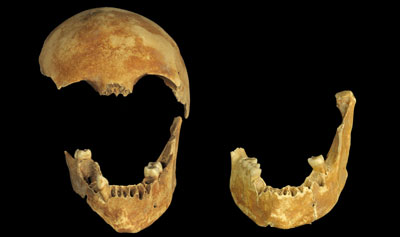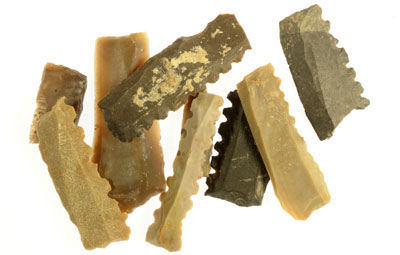(Communicated by the Israel Antiquities Authority)
A rare well dating to the Neolithic period was uncovered in recent
excavations the Israel Antiquities Authority carried out at 'Enot Nisanit',
along the western fringes of the Jezreel Valley prior to enlarging Ha-Yogev
Junction (Highway 66) by the National Roads Company. Archaeologists estimate the
well was built approximately 8,500 years ago.
During the excavations the skeletal remains of a woman approximately 19 years
of age and a man older than her were uncovered deep inside the well. How did
these come to be in the well? Was this an accident or perhaps murder? As of now
the answer to this question remains a mystery.


Photo courtesy of the Israel Antiquities Authority
According to Yotam Tepper, excavation director on behalf of the Israel
Antiquities Authority, "What is clear is that after these unknown individuals
fell into the well it was no longer used for the simple reason that the well
water was contaminated and was no longer potable." Tepper adds, "The impressive
well that was revealed was connected to an ancient farming settlement and it
seems the inhabitants used it for their subsistence and living. The upper part
of the well was built of stones and its lower part was hewn in the bedrock. Two
capstones, which narrowed the opening, were set in place at the top of the well.
It is c. 8 meters deep and its upper part measures about 1.3 meters in
diameter."
Tepper says, "Numerous artifacts indicating the identity of the people who
quarried it - the first farmers of the Jezreel Valley - were recovered from
inside the well. The finds include, among other things, deeply denticulated
sickle blades knapped from flint which were used for harvesting, as well as
arrow heads and stone implements. The excavation of the accumulations in the
well shaft yielded animal bones, organic finds and charcoal which will enable
future studies about the domestication of plants and animals, and also allow
researchers to determine the exact age of the well by means of advanced methods
of absolute dating."


Flint implements exposed during the excavation
(Photo: Clara Amit,
courtesy Israel Antiquities Authority)
"The well that was exposed in the Jezreel Valley reflects the impressive
quarrying ability of the site's ancient inhabitants and the extensive knowledge
they possessed regarding the local hydrology and geology which enabled them to
quarry the limestone bedrock down to the level of the water table. No doubt the
quarrying of the well was a community effort that lasted a long time", said
Tepper.
According to Dr. Omri Barzilai, head of the Prehistory Branch of the Israel
Antiquities Authority, "Wells from this period are unique finds in the
archaeology of Israel, and probably also in the prehistoric world in general.
The two oldest wells in the world were previously exposed in Cyprus and they
indicated the beginning of the domestication phenomenon: it seems that ancient
man tried to devise ways of protecting his drinking water from potential
contamination by the animals he raised, and therefore he enclosed the water in
places that were not accessible to them.
The wells had another important advantage: quarrying them provided access to
an available source of water that was not dependent upon springs or streams.
Another well, which is about 1,000 years later than those in Cyprus, was
previously exposed at the Atlit Yam site in Israel, and another well from this
period has now been exposed at the 'Enot Nisanit' site. The exposure of these
wells makes an important contribution to the study of man's culture and economy
in a period when pottery vessels and metallic objects had still not yet been
invented."
The Israel Antiquities Authority and National Roads Company will act to
conserve the well and exhibit it as part of the sites around Tel Megiddo in the
different periods.